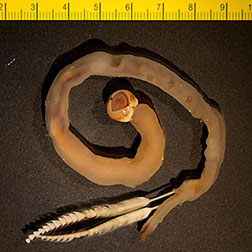- Number 427 |
- November 24, 2014
How to eat a wooden ship, shipworm-style

Despite its name, the shipworm is actually
a clam with a unique digestive strategy.
(Dan Distel, Ocean Genome Legacy Center
of New England Biolabs)
Shipworms have been called “termites of the sea” because they’ve been vexing seafarers for centuries. Among the problems attributed to them are events such as flooding of the Netherlands in the 18th and 19th centuries, and they were also responsible for an estimated $15 million in damages to the wharves of San Francisco, California around 1920.
For bioenergy researchers at the U.S. Department of Energy Joint Genome Institute (DOE JGI), a DOE Office of Science User Facility, the shipworm’s destructive capabilities could prove useful for the industrial production of advanced biofuels from plants. For this reason, under the DOE JGI’s Community Science Program, a team led by collaborator Daniel Distel, Director of the Ocean Genome Legacy Center of New England Biolabs at Northeastern University, has focused on the shipworm Bankia setacea to learn more about the enzymes it utilizes to break down wood for nutrition.
In a study published ahead online November 10, 2014 in Proceedings of the National Academy of Sciences, the team led by Tufts Medical Center’s Roberta O’Connor and Distel, and including DOE JGI researchers described the shipworm’s strategy in breaking down and digesting wood. Learn more at http://jgi.doe.gov/termite-seas-wood-destruction-strategy-revealed/. The shipworm’s story was also featured in the Washington Post at wapo.st/1tCYkrj.[Massie Ballon, 925.927.2541,
mlballon@lbl.gov]
